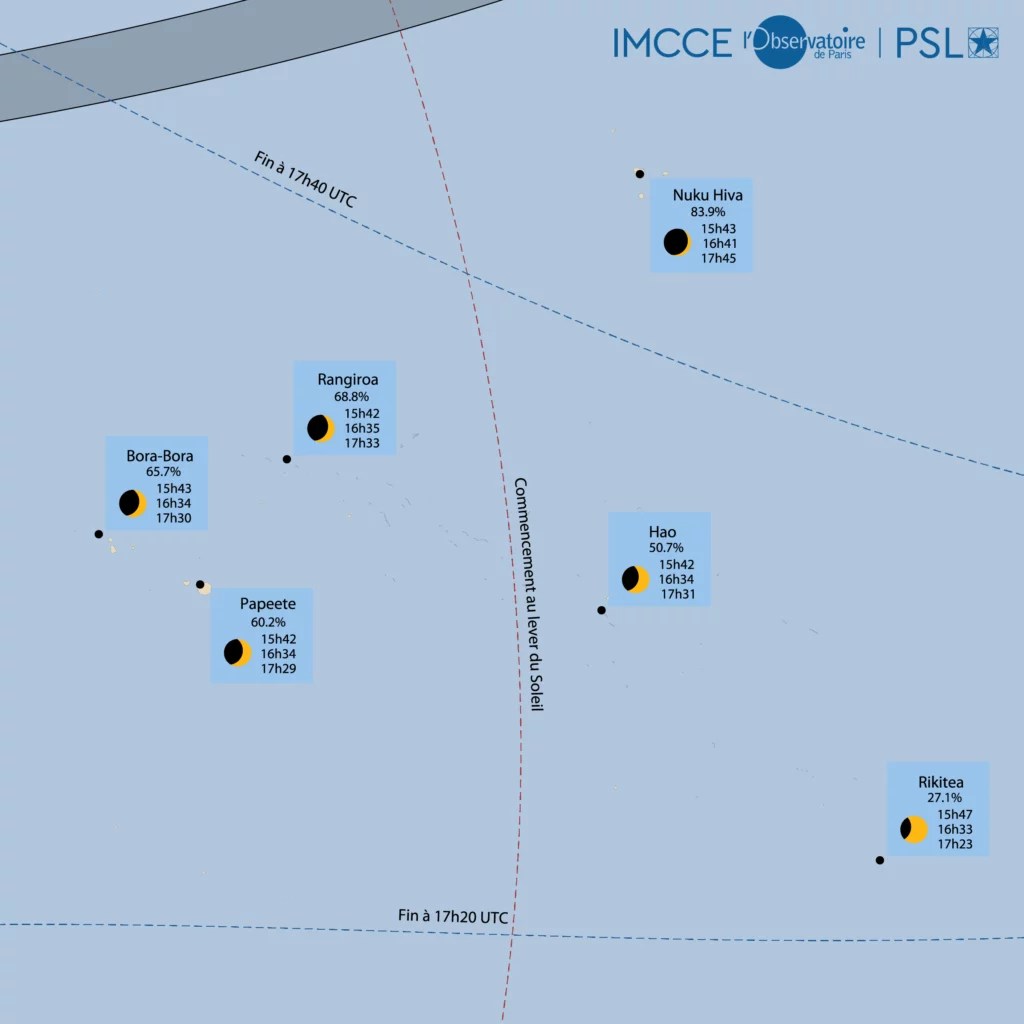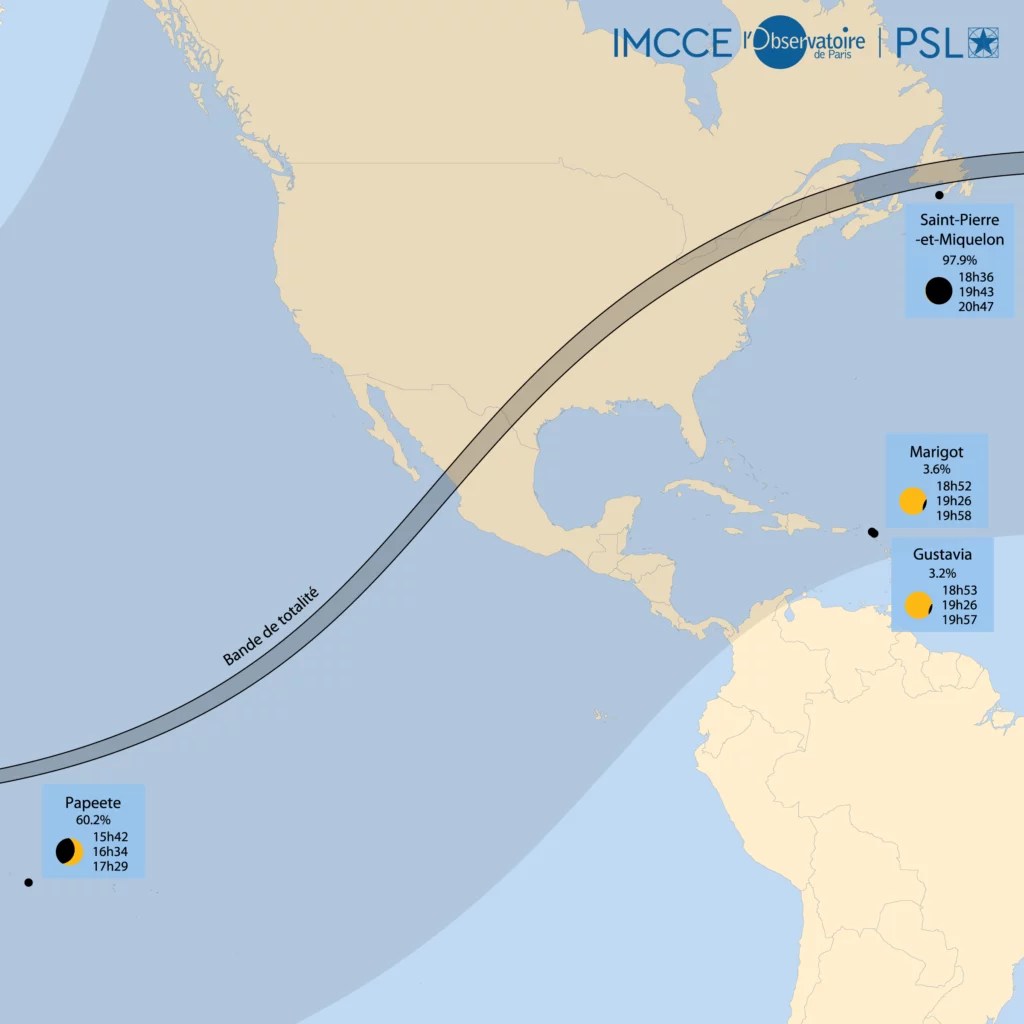A total solar eclipse occurs on April 8, 2024. Mainland France has no chance of seeing the spectacle, but part of overseas France is well placed to admire the Sun eclipsed by the Moon.
The Moon is about to come between the Earth and the Sun. The next solar eclipse takes place on Monday April 8, 2024. Only a small part of the planet can hope to witness it. Mainland France is unfortunately not one of them. However, parts of overseas France will be in the visibility zone. The eclipse will be partial from French Polynesia and almost total from Saint-Pierre and Miquelon, indicates the Institute of Celestial Mechanics and Ephemeris Calculation (IMCCE) in its forecasts of the phenomenon.
The totality band of the solar eclipse, that is to say the narrow zone in which an observer will see the Moon completely occulting the Sun at the maximum of the phenomenon, begins in the Pacific Ocean. It passes through Mexico, the United States, Canada and ends in the Atlantic.

What happens during a solar eclipse?
During a solar eclipse, the Moon passes in front of the Sun, as seen from Earth. “ Although the Moon is incomparably smaller than the Sun, it is close enough to the Earth that its apparent diameter is approximately equal to that of the Sun and that total solar eclipses can be observed. », recalls the IMCCE.
Only observers located in the band of totality (or centrality when the eclipse is not total) see the phenomenon of a solar eclipse at its maximum. If we find ourselves in the penumbra zone, we witness a partial eclipse. Outside of this area, nothing particular is observed.
What will we see during the eclipse of April 8, 2024 in French Polynesia?
The solar eclipse will be visible in some islands of French Polynesia. “ The phenomenon will follow the rising of the Sun which will be temporarily eclipsed by the Moon, like a race to whoever will rise first », Indicates the IMCCE. The phenomenon will be especially observable for early risers and people going up to the heights of Tahiti, warns the institute.


What will we see in Saint Pierre and Miquelon during the eclipse of April 8, 2024?
The French archipelago of Saint-Pierre-et-Miquelon, off the coast of Canada, will be very well placed for this solar eclipse. The obscuration of the Sun will be almost total during the eclipse, promising beautiful observations, according to the IMCCE.


How long does the April 8, 2024 solar eclipse last?
The entire solar eclipse on April 8, 2024 lasts 5 hours and 10 minutes, including 3 hours and 16 minutes for the central phase. The following table, based on IMCCE data, indicates the general circumstances of the eclipse.
| Phase | Instant (Paris time) |
|---|---|
| Start of the general eclipse | 5:42 p.m. |
| Start of total eclipse | 6:18 p.m. |
| Start of the central eclipse | 6:40 p.m. |
| Maximum of the eclipse | 8:17 p.m. |
| End of central eclipse | 9:54 p.m. |
| End of total eclipse | 9:55 p.m. |
| End of the general eclipse | 10:52 p.m. |
How to observe a solar eclipse?
It is essential to remember that we never look at the Sun directly with the naked eye, whether or not there is an eclipse in progress. The Sun’s rays can burn the retina, with irreversible consequences.. This danger is all the greater if the burn is painless when it occurs.
The only safe methods for observing an eclipse are:
- Wear certified eclipse glasses, bearing the marking of European directive 89/686/EEC. The glasses must be recent (less than a year old) and in good condition. Forget eclipse glasses that have already been used and have been stored without precautions. Beware of non-protective glasses sometimes promoted on Amazon, prefer stores specializing in astronomy.
- Observe the eclipse indirectly, by projection. Use a cardboard box without a lid (a shoe box for example), pierce a hole in one of the walls and observe the image of the Sun projected in the box, on the opposite wall. This also works using two sheets, one with a hole.
Under no circumstances should sunglasses be used to look at the Sun. If you don’t have suitable protection, there is only one thing to do: don’t watch the eclipse.
Subscribe for free to Artificielles, our newsletter on AI, designed by AIs, verified by Numerama!
